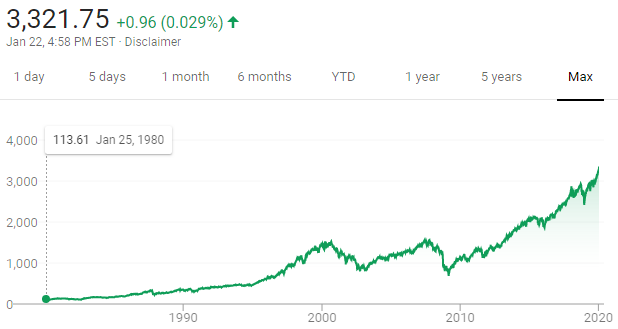
Diversify your positions. Buy. Then hold on to them for as long as you can.
That’s really all it takes to consistently profit from equities investments.
Evidence increasingly indicates that professional investment managers can’t get long run returns better than index based funds. As long as you diversify your holdings sufficiently, it doesn’t really matter which way the economic wind goes. Is Coke going to outsell Pepsi? Will Delta sell more seats than American? If you own all four of those companies, you just care that those airline seats are full and the travelers are drinking lots of soda.
Of course, index funds don’t do so well when the economy in general is bad, but that brings us to the first point:
Table of Contents
Why buy stocks?
You can’t really make much money off “safe” investments like government bonds and bank deposits. In fact, most of those safer investments fail to beat the inflation rate.
Housing, on average, has outperformed inflation by about 1%. So it’s a decent investment – but stocks have performed at about 7% above inflation over that same 70 year time frame. So if you took the money you would’ve put toward an extra mortgage payment in to an index fund instead, you’d end up with more money!
Warning: Past performance does not guarantee future results
Things change and the past is no proof of what the future will be. That’s the risk that goes along with any sort of investment. It’s a large part of what justifies the returns, too.
Systematic risks from credit market malfunction to global warming could undermine the entire global economic order as we know it. Governments may move to nationalize existing firms or tax capital ownership at rates we’ve never seen before.
No one knows the future… but there are ways you can minimize your risks…
How and Why to Diversify
If all your money is tied up in a single stock, you should be ready for an unpleasant roller coaster ride of unpredictable highs and lows. In a worst case scenario, the company could go bankrupt and you’d be left with nothing.
The fundamental idea behind diversification is risk mitigation. Every additional position you take reduces your total risk of experiencing a catastrophic result. From the example earlier, owning shares of competing stocks can give you exposure to broad market trends within that sector without necessarily forcing you to pick a winner. If American Airlines goes out of business, Delta is likely to get more customers after all.
But if the airline industry suffers, your portfolio will too.
So we diversify more – in to additional sectors:
- Consumer Discretionary
- Consumer Staples
- Energy
- Financials
- Health Care
- Industrials
- Information Technology
- Materials
- Real Estate
- Telecommunication Services
- Utilities
The Global Industry Classification Standard defines those 11 sectors to begin classifying the types of companies that compose the global economy.
There are also broad market funds like SCHB and VTI that allow you to cheaply buy shares of thousands of different companies – literally every publicly traded company that their fund managers can find. Again, you’re not betting on winners or losers so much as you’re betting that the U.S. economy, as a whole, will continue to grow with time.
(Full disclosure: I own SCHB and VTI and at least that very little bit of about 4000 companies that those funds holds stocks in. I also have some ETFs with exposure to European and Asian markets.)
And then what? Hold and Repeat!
Stock investing should never be treated as a get rich quick scheme. Money placed in to risky and highly leveraged positions can easily and instantly disappear, while safer index strategies use the momentum of time and stability – and compound interest – to grow in to massive accounts over the years.
Thanks to compounding interest, all the money your investments gain (if re-invested!) can increase the amount of investment gains. Basically, it’s a feedback loop, and it’s a good one for your net worth. Buy stocks, get profits. Use profits to buy stocks, get even more profits.
What about timing the market?
Statistically, most traders who are trying to time the market will not perform as well as those who buy and hold for the long haul. Ups and downs are clear in hindsight, but attempting to guess tomorrow’s movements is about as reliable as guessing the lottery numbers. And remember, you have to time it twice just to open and close out a single position: once at the top and once at the bottom.
In the long run, the market trend is up, and the earlier you get in and the longer you hold, the bigger returns you’ll see.
…and the Fine Print
Even with a simplified portfolio structure, there are still a lot of details to learn that can impact your returns. Certain types of accounts have certain tax advantages, but they also come with restrictions on how or when you can access that money. 401ks and IRAs let you defer taxes or pay future taxes, but there are limits to how much you can contribute and you won’t be able to access the money (without penalty) until you’re 59 and a half.
Timing is also something to consider – even though it’s often something completely out of our control. If you come to whatever retirement age you’ve decided on and a market crash hits early in that retirement, you’re going to lose a much larger percentage of your money than if you retire 10 years before the next market downturn.
So risks still exist and nothing’s guaranteed, but you’ll still be better off than if you hadn’t saved up and invested at all. Unless, well, the entire socio-economic structure of the planet collapses or is replaced by any non-capitalist system. Those are topics for another day, however!


Leave a Reply